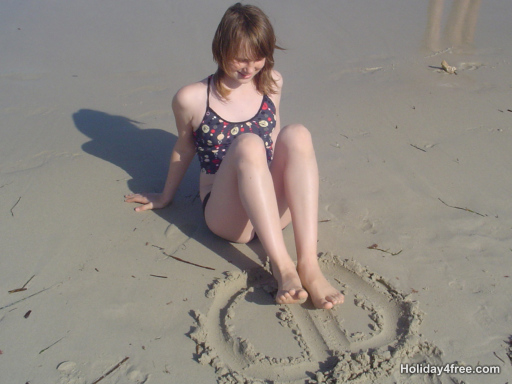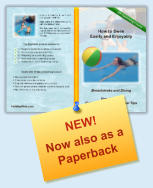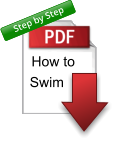








How to swim & how to dive
9.2. Consciously practicing, automate
and the right leg movement
In practice, it has proved effective to initially shift the leg movement to the front, within the learner's field of vision, and to practice it without water at first. This allows the eyes to consciously observe the movements of the legs and small technical mistakes to be put right by the learner themselves. This makes it easier to learn the leg movement, which gives the learner an experience of success and motivates them. An exercise to do at home: The legwork exercise is suitable for practicing in the sand, or at home on a smooth floor. The learner sits down and practices doing the frog movement with their legs: “Slowly draw the legs up, then open and straighten them with a powerful push away from the body and bring them together stretched out to the front. When opening the legs, the knees should point outwards and the tips of the toes should point upwards.” This new movement can learned be more attentively and consciously on land, as in the water most of a learner’s concentration is needed to orient themselves, to maintain their balance and to keep their airways free. Once the learner has internalized the sequence of movements, they can continue practicing in the water. When making the first attempts in the water, it makes sense to practice the legwork while on one’s back in the water. The learner’s buoyancy can be supported using a floatation aid or a helping hand from the teacher. In this way, the learner can also see their own legwork in the water and improve it themselves. As soon as that movement has become automatic, the learner can go on to practice in the breast position. This method makes it easier to move the legs correctly in the breast position, even when they are outside the learner's field of vision. Extra tip from practical experience: Children quickly become bored if they have to do the exercise alone. Try to arrange for them to do the dry exercise together with another child, to a song or melody. You can also count the number of movements by counting down from 10 to 0 in a different language. The child should learn to do the correct movements automatically over many days. Next step: Learn to swim - 10. Learning to swim with the ears
Ad
Ad
Ad
How to Swim 9.2./20
Swimming Exercise
Tips drawn from practical experience
to support the learning process,
with or without a swimming course.

© Holiday4free.com
swimming exercise




Home
Ad



Ad
Ad












